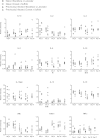Local cytokine transcription in naïve and previously infected sheep and lambs following challenge with Teladorsagia circumcincta
- PMID: 24712712
- PMCID: PMC4234407
- DOI: 10.1186/1746-6148-10-87
Local cytokine transcription in naïve and previously infected sheep and lambs following challenge with Teladorsagia circumcincta
Abstract
Background: The abomasal helminth Teladorsagia circumcincta is one of the most economically important parasites affecting sheep in temperate regions. Infection is particularly detrimental to lambs, in which it can cause pronounced morbidity and severe production losses. Due to the spreading resistance of this parasite to all classes of anthelmintic drugs, teladorsagiosis is having an increasingly severe impact on the sheep industry with significant implications for sheep welfare. Protective immunity develops slowly, wanes rapidly and does not appear to be as effective in young lambs. To investigate the development of immunity to T. circumcincta in sheep and lambs, we used cytokine transcript profiling to examine differences in the abomasal mucosa and gastric lymph node of naïve and previously infected sheep and lambs following challenge.
Results: The results of these experiments demonstrated that the abomasal mucosa is a major source of cytokines during abomasal helminth infection. A local Th2-type cytokine response was observed in the abomasal mucosa and gastric lymph node of the previously infected sheep and lambs when compared with those of the naïve during the early stages of infection. In contrast, a pro-inflammatory component more was evident in the abomasal mucosa and gastric lymph node of the naïve sheep when compared with those of the previously infected, which was not observed in the lambs.
Conclusions: The greater levels of Th2-type cytokine transcripts in both the abomasum and gastric lymph node of the previously infected compared with naïve sheep and lambs emphasises the importance of these mechanisms in the immune response to T. circumcincta infection. Younger lambs appear to be able to generate similar Th2-type responses in the abomasum suggesting that the increased morbidity and apparent lack of resistance in younger lambs following continuous or repeated exposure to T. circumcincta is unlikely to be due to a lack of appropriate Th2-type cytokine production.
Figures





Similar articles
-
A differential interplay between the expression of Th1/Th2/Treg related cytokine genes in Teladorsagia circumcincta infected DRB1*1101 carrier lambs.Vet Res. 2011 Mar 8;42(1):45. doi: 10.1186/1297-9716-42-45. Vet Res. 2011. PMID: 21385411 Free PMC article.
-
Effects of Teladorsagia (Ostertagia) circumcincta infection on lambs selected for high fleece weight.Vet Parasitol. 2009 Nov 12;165(3-4):256-64. doi: 10.1016/j.vetpar.2009.07.030. Epub 2009 Jul 19. Vet Parasitol. 2009. PMID: 19671487
-
Local eosinophil- and mast cell-related responses in abomasal nematode infections of lambs.FEMS Immunol Med Microbiol. 1994 Feb;8(2):167-73. doi: 10.1111/j.1574-695X.1994.tb00439.x. FEMS Immunol Med Microbiol. 1994. PMID: 8173555
-
The genetic basis of resistance to Ostertagia circumcincta in lambs.Vet J. 1997 Sep;154(2):111-9. doi: 10.1016/s1090-0233(97)80049-4. Vet J. 1997. PMID: 9308398 Review.
-
How lambs control infection with Ostertagia circumcincta.Vet Immunol Immunopathol. 1999 Dec 15;72(1-2):213-8. doi: 10.1016/s0165-2427(99)00134-8. Vet Immunol Immunopathol. 1999. PMID: 10614511 Review.
Cited by
-
The host immune response to gastrointestinal nematode infection in sheep.Parasite Immunol. 2015 Dec;37(12):605-13. doi: 10.1111/pim.12290. Parasite Immunol. 2015. PMID: 26480845 Free PMC article. Review.
-
Mucosal Expression of T Cell Gene Variants Is Associated with Differential Resistance to Teladorsagia circumcincta.PLoS One. 2016 Dec 14;11(12):e0168194. doi: 10.1371/journal.pone.0168194. eCollection 2016. PLoS One. 2016. PMID: 27973603 Free PMC article.
-
Variable exon usage of differentially-expressed genes associated with resistance of sheep to Teladorsagia circumcincta.Vet Parasitol. 2015 Sep 15;212(3-4):206-13. doi: 10.1016/j.vetpar.2015.08.023. Epub 2015 Aug 28. Vet Parasitol. 2015. PMID: 26330386 Free PMC article.
-
Contribution of the Immune Response in the Ileum to the Development of Diarrhoea caused by Helminth Infection: Studies with the Sheep Model.Funct Integr Genomics. 2022 Oct;22(5):865-877. doi: 10.1007/s10142-022-00864-6. Epub 2022 May 16. Funct Integr Genomics. 2022. PMID: 35576023 Free PMC article.
-
Mucosal Immunity of Major Gastrointestinal Nematode Infections in Small Ruminants Can Be Harnessed to Develop New Prevention Strategies.Int J Mol Sci. 2024 Jan 24;25(3):1409. doi: 10.3390/ijms25031409. Int J Mol Sci. 2024. PMID: 38338687 Free PMC article. Review.
References
-
- Miller JE, Horohov DW. Immunological aspects of nematode parasite control in sheep. J Anim Sci. 2006;84(Suppl):E124–E132. - PubMed
Publication types
MeSH terms
Substances
Grants and funding
LinkOut - more resources
Full Text Sources
Other Literature Sources

